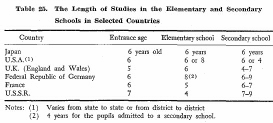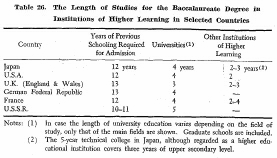| Home > Policy > White Paper, Notice, Announcement > White Paper > EDUCATIONAL STANDARDS IN JAPAN 1965 > CHAPTER |
||
Elementary and secondary schools. The e1ementary period of learning is six years in most countries, but the secondary period of learning varies from country to country due to the difference in the structure of education. In our country and also in the most parts of the United States of America, secondary education extends six years. In European countries and the U.S.S.R., the length of each secondary school differs according to its aims and character. In European countries, the secondary school oriented toward higher education extends seven to nine years, and in the U.S.S.R., six to seven years.

Institutions of higher education. As each country has various types of higher educational institutions, it would be greatly complicated to compare the length of all types separately. Accordingly it will suffice here to make comparison for universities only. For the other types of institutions such as teachers colleges, junior colleges, professional schools, etc., only the ranges i.e. the shortest and the largest, are presented.

The length of university courses leading to the baccalaureate degree can be said to be generally 4 years, although it varies from 3 to 5 years due to the difference in the length of previous schooling required for admission to the university. On the other hand, the length of the courses in institutions other than the university varies considerably.
| Back to Top | MEXT HOME |